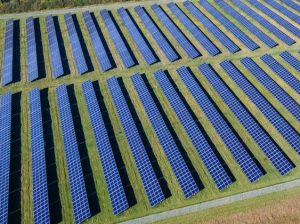By SJ Tomasco
Your Pace Student
University Times Contributor
SKOWHEGAN, ME– From the roadside, along Route 2 in Skowhegan Maine, a field harboring a new cash crop emerges, drawing the eye from the surrounding landscape. What was once 18 acres of forest and grasslands is now filled with energy-producing solar panels generating 4.9 gigawatt hours of clean energy annually, enough to power approximately 500,000 homes. With the global rise in natural disasters caused by climate change, international leaders have placed renewable energy at the forefront of both political and environmental discussions.
Nationally, state and federal governments have implemented policies to lessen the impacts of climate change and lower the country’s carbon footprint by 2050. Because of these incentives, and increasing support for renewable energy, the emergence of solar farms across the United States of America (US) has surged. This phenomenon is evident not just in statistical data, but also in the evolving the natural setting of the country. Statistics from Solar Market Insights indicate that the solar business experienced a remarkable 55% rise in 2022, followed by a record-breaking growth in 2023. As of the conclusion of the previous year, the US installed around 33 gigawatts of solar capacity.
While some Maine residents have greeted solar farms with optimism, others worry that the damage from these farms far outweighs their benefits.
Amid the scarcity of prime farmland and wildlife habitat in the nation’s most forested state, voters have expressed apprehension regarding the loss of both. The lack of environmental protection policies that ensure safeguards against land degradation and the lack of transparency by government and industry leaders contribute significantly to the criticism of solar energy.
Two-thirds of American adults support the use of both fossil fuels and renewable energy sources, according to data collected by the Pew Research Center. Despite this, support for creating solar farms is waning.
Sarah Haggerty, a biologist and conservationist for the Maine Audubon Society, voiced her concerns. She pointed out that Maine is losing both habitats and farmland.
Other residents echoed her sentiments.
Tim Tomasco, a solar electrician, has worked for Revision Energy, one of the largest solar producers in New England. He noted that there are huge amounts of land that have become solar fields, and little thought goes to the repercussions.
“Another big negative impact is where and how we get the materials,” he said. “That is never a good thing.”
He considered who should carry the burden of blame and responsibility for this destruction,
“There’s a little blame to go around, from top to bottom,” said Tomasco.





